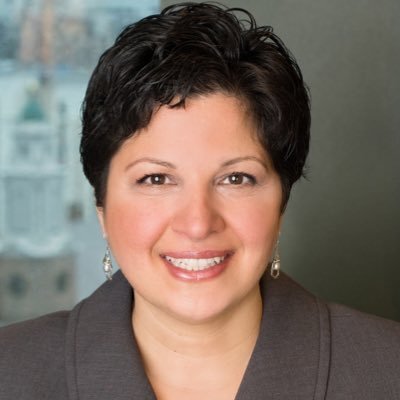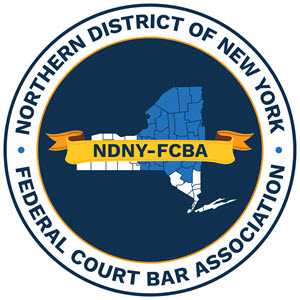By Janelle Pelli
Tina Sciocchetti is a partner at Nixon Peabody. A Capital Region native, she discussed her prior jobs as a federal prosecutor in Albany and Washington D.C., her transition to private practice, and her efforts to forge stronger bonds among lawyers doing white-collar criminal defense and investigations in the Northern District of New York. 
1. To start, can you give us an overview of your career and your current practice?
Following graduation from Northwestern University law school, I clerked for Hon. Max Rosenn on the Court of Appeals for the Third Circuit. He was a long-serving, dedicated, public servant and the consummate model of civility and humility in the practice of law. With every case, he emphasized consideration for the real-life impact of his decisions on the lives of litigants and the greater community. It was a lesson that humanity and respect for others must be at the core of our work as lawyers. Like all his clerks, I have sought to follow his example.
I spent the first seven years of practice in the District of Columbia, first as a litigation associate at Latham and Watkins, then as an Assistant United States Attorney (“AUSA”) in the District. In 1999, I moved home to Upstate NY and served as an AUSA in the Northern District of New York (“NDNY”). Twelve years into that role, I was appointed to an executive position at the NYS Education Department where I managed statewide investigations of school personnel, oversaw licensure actions, developed and executed a testing integrity unit, and served as the Department’s Chief Privacy Officer.
In 2016, Nixon Peabody invited me to join their partnership. In my nine years there, I have specialized in complex civil and criminal matters involving government investigations, white-collar criminal defense, and qui tam/False Claims Act cases. I also counsel educational institutions in all areas of operations and compliance, with a focus on Title IX, sexual harassment, and student disciplinary matters. My pro bono work includes obtaining name changes for transgender clients, assisting immigrants obtain legal status, and serving on Diversity Lab’s Disability Inclusion Advisory Group.
I currently serve as a lead in the firm’s Women’s Resource Group and on the board of The Legal Project, an organization that provides free civil legal assistance to individuals who cannot afford a lawyer, including needy victims of crime, immigrants, veterans, and the elderly.
2. What do you find most rewarding about your practice?
The most rewarding days are the ones on which I obtain a fair and just result for my client. When the full promise of our justice system is realized, I am reminded that my work is part of something bigger than any individual client, and I am inspired to continue practicing. It’s also gratifying to convince the government to decline an investigation or close a case involving a client.
Here in the NDNY, we are a small but quickly expanding group of white-collar practitioners. A few years ago, I started the Albany White Collar Group to cultivate and support white-collar practice in this region, and I am pleased to see growing numbers join the group with every event, especially more women.
As I enter my years of practice as a relative elder (30+ since law school), I also find mentoring younger lawyers exceptionally rewarding. I remember how much self-doubt and anxiety the practice of law can trigger within you until you build expertise and confidence. I try to be a supportive and mindful teacher for our young talent and pave the way for their success.
3. What drew you to become an Assistant United States Attorney?
As I was toiling away as an associate in Big Law, I realized that my interests lay in criminal law. I called contacts who did white-collar work in law firms – then a nascent field with a handful of practitioners – and asked what they recommended I do to enter the field. To a person they told me to become an AUSA. Those who had been prosecutors said it was the best job they ever had. I walked to the law library, pulled down a federal reporter (this was the years before the internet) and identified every U.S. Attorney’s Office in a city where I was willing to live. Luckily, Former Attorney General Eric Holder (the U.S. Attorney in D.C. at the time) saw something in me and I was able to stay in D.C. and serve my community there.
4. What were the highlights of your time as an Assistant United States Attorney?
It seems cliché, but you never take for granted that you are representing the United States of America when you appear in court. That carries an awesome responsibility for a lawyer and you do everything you can to live up to the expectations. In D.C., the AUSAs handle traditional DA-type cases so in my five years in that role there, I handled all manner of criminal cases from misdemeanors to complex felonies, in local and federal court. For two years, I specialized in child/adult sexual abuse prosecutions. Nothing was more significant and fulfilling for me than getting justice for rape victims (especially children) and convicting serial rapists. In transnational crimes, I worked with the CIA and State Department to convict a terrorist, establishing favorable law for future terrorism prosecutions. Given the volume of cases – in some sections we had a trial scheduled every day – the pace was fast, and I was able to hone my skills as a trial lawyer. There were exceptional trial attorneys in the office and the best training came in watching their trials.
When I transitioned to the NDNY U.S. Attorney’s Office, I found the Federal Defenders and NDNY defense bar refreshingly civil and collegial, and very much enjoyed being part of the extended NDNY courthouse family. With an entirely federal practice and a larger jurisdiction, the cases in the NDNY were more complex and diverse. One career highlight involved an immigration case that ultimately netted 16 guilty pleas from corporate managers and a corporate fine of over $18 million dollars – a record for that type of case. A federal law enforcement agency awarded me its “Prosecutor of the Year” award for my work, and I was told that the President had learned about my case during his daily presidential briefing. That was pretty neat.
5. How did you end up in Upstate New York?
My mom came to Schenectady from Italy at the age of 15 and a few years later – after they married – my father joined her from Italy. More relatives arrived after them and an extended family clan developed in the Capital District during the 50’s and 60’s. I am the sixth of seven children, and my siblings have settled here. My sisters and brothers are my closest friends, and their kids are like my own. Essentially, I came home when my husband and I were ready to start our own family so we could raise our children in the love and support of this tight-knit family.
6. What challenges do you face defending clients facing potential criminal charges?
People often ask me if I find it hard to represent defendants having been a prosecutor for so long, but I don’t. I have learned the truth in Bryan Stevenson’s observation that “Each of us is more than the worst thing we’ve ever done.” My clients have families, they’ve built businesses, and many have achieved stature in their communities. They come to me at their lowest moment. Oftentimes, they’ve done things in the face of incredible pressures. They need my help, and I am privileged to have the skills to help them navigate the consequences of their actions.
The most difficult personal challenge I face is not internalizing the stress, fear, and anxiety that my clients experience when facing the prospect of incarceration and separation from their loved ones, and the loss of their life’s work or business. I have had sleepless nights worrying about them.
7. What makes for an effective cross-examination of a witness at trial?
In my experience, a jury does not appreciate conflict. Conflict makes people uncomfortable and because the cross-examiner is the source of that discomfort, it hurts a lawyer’s case to argue with or berate a witness. Ask your questions politely. If the witness is squirrely and evasive or argumentative, the jury will pick up on it and dislike the witness for frustrating the jury’s truth-finding goal.
8. How do you connect with the jury as a litigator?
Speak to them in plain, non-legalese. You’re not there to impress them but to help them understand your client’s defense. Always be considerate of their time – limit interruptions of the flow of trial and keep your questioning and arguments precise. Be professional to the other party and respectful of the court. So much communication and connection to the jury depends not on what comes out of your mouth but on how you behave in their presence.
9. What do you see as emerging areas for the white-collar defense bar to tackle?
There is an onslaught of changes in government policies and priorities coming from the new administration in Washington. The administration is seeking to employ traditional tools from its enforcement toolbox to implement these changes in ways we haven’t previously seen. For example, the Department of Justice just recently announced an initiative to apply the federal False Claims Act to combat alleged civil rights violations by recipients of federal funds such as contractors, grantees, and universities. DOJ has signaled a willingness to reconsider and decline existing corporate investigations and prosecutions. Institutional clients require almost daily counseling and guidance on how to comply and avoid risking an investigation or adverse action. Related federal demands for records and investigations are happening on expedited timelines. These quick, complex, high-stakes circumstances call for the assistance and advocacy of experienced white-collar counsel.
10. What are your hobbies or favorite things to do outside of work?
If I have a free day, I’m spending it in any one of the many quaint towns within driving distance of home, exploring the restaurants, bookstores, boutiques, and cultural attractions. My husband often plans hikes for us in the Adirondacks or Catskills (which I enjoy if they’re short enough). I am an avid traveler and jigsaw puzzler and most nights – when I should be sleeping – I am completing every puzzle option the NY Times serves up that day.

